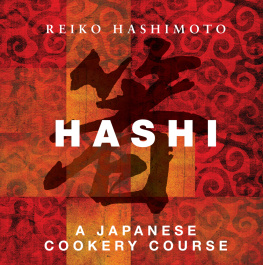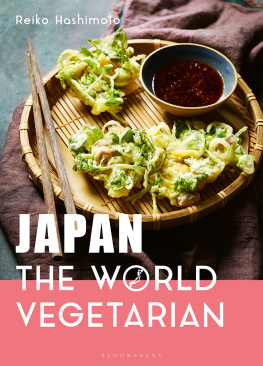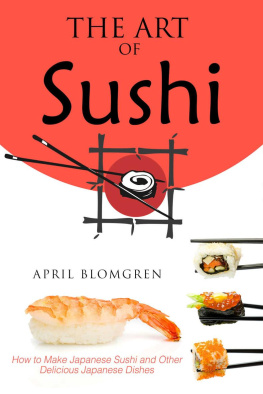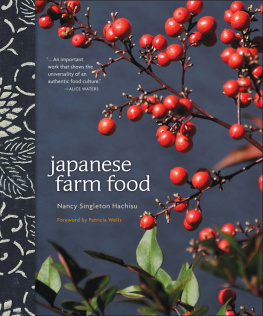
To Luiz
I want to thank my dear friend, Luiz Hara, who has been supporting my cookery courses over the years. As well as his full time investment bank job, Luiz runs an extremely popular food blog called The London Foodie. I first met Luiz in my Sushi and Sashimi class back in 2005; he had come back for various courses I was offering at the time. Luiz kindly tells me that he has enjoyed every single course he has taken and has consequently gained a true understanding and appreciation of Japanese food. When I receive this kind of comment from my students, it does make me realise how lucky I am to be doing what I do. I am extremely grateful to have met Luiz and to be able to share and exchange our knowledge of food. I feel very lucky to have such a precious friend who has faith in my food and supports my work. Thank you, Luiz.
Absolute Press, an imprint of Bloomsbury Publishing
First published in Great Britain in 2011 by
This digital edition released in 2016
Bloomsbury is a registered trademark of Bloomsbury Publishing Plc
Absolute Press
Scarborough House
29 James Street West
Bath BA1 2BT
Phone 44 (0) 1225 316013
Fax 44 (0) 1225 445836
E-mail
Website www.absolutepress.co.uk
Text Reiko Hashimoto
Photography Mike Cooper
(except cover montage images from Fotolia.com: alte papier
suzannmeer; and red fabric background Freesurf, both of which also appear inside this book)
Publisher Jon Croft
Commissioning Editor Meg Avent
Art Direction & Design Matt Inwood
Design Assistant Claire Siggery
Editor Anne Sheasby
Photographer Mike Cooper
Food Stylist Reiko Hashimoto
ISBN: 978-1-9066-5057-5
ePub: 978-1-4729-3312-6
A catalogue record of this book is available from the British Library.
The rights of Reiko Hashimoto to be identified as the author of this work have been asserted by her in accordance with the Copyright Designs and Patents Act 1988.
All rights reserved
You may not copy, distribute, transmit, reproduce or otherwise make available this publication (or any part of it) in any form, or by any means (including without limitation electronic, digital, optical, mechanical, photocopying, printing, recording or otherwise), without the prior written permission of the publisher. Any person who does any unauthorised act in relation to this publication may be liable to criminal prosecution and civil claims for damages.
A note about the text
This book is set in Minion, Helvetica Neue and Sabon MT. Minion was created by Robert Slimbach, inspired by fonts of the late Renaissance. Helvetica was designed in 1957 by Max Miedinger of the Swiss-based Haas foundry. In the early 1980s, Linotype redrew the entire Helvetica family. The result was Helvetica Neue. Sabon was designed by Jan Tschichold in 1964. The roman design is based on type by Claude Garamond, whereas the italic design is based on types by Robert Granjon.
To find out more about our authors and books visit www.bloomsbury.com. Here you will find extracts, author interviews, details of forthcoming events and the option to sign up for our newsletters.
ABOUT THE AUTHOR
Reiko Hashimoto has been teaching Japanese cooking for over 12 years. In that time, she has set thousands of students on the path to creative and accessible Japanese cooking. Now she has the pleasure of sharing her culinary secrets with you.
Reiko was born in Kyoto, the ancient capital of Japan. She grew up in a traditional Japanese family with a food-fanatic mother who has shaped her love of Japanese cooking today.
After studying English Literature at university, Reiko started work as an airhostess and was based in Hong Kong, a real foodies paradise. Travelling around the world with her airline broadened Reikos understanding and interest in food from all corners of the globe. After leaving the airline, Reiko decided to make a career from cooking and teaching, by introducing Japanese cuisine to her foreign friends living in Japan.
Reiko then moved to London and set up a company called HASHI to cater for Japanese dinner parties from formal sit-down dinner parties to casual canap parties. A lot of the people Reiko catered for asked if she could teach them how to cook, and so Reiko then decided to also teach Japanese cooking.
So, for nearly 10 years, Reiko has been teaching people the joy of Japanese cooking, coaching them from raw beginners to cordon bleu-level chefs. She has appeared on television many times and has been featured on programmes such as Good Food Live and The Great British Kitchen as a guest chef. She has also been featured in numerous magazine articles.
To many, Reiko is the acknowledged expert in Japanese cooking in the UK. And now she has taken her love of Japanese food one step further by producing this beautifully presented definitive book on how to cook Japanese food at home.

FOREWORD
I was very fortunate to be brought up in a family that always had freshly cooked meals prepared by my mother who was very keen on fresh flavours and very fresh food. I remember waking up every morning and going downstairs to the sound of a shaving noise in the kitchen. Mother was shaving the solid dried and smoked bonito fish to make the flakes for dashi stock. Not only did she make the stock from scratch each morning most Japanese people buy bonito flakes already shaven and use sea kelp (konbu or kombu) to make fresh stock but she actually shaved the fish every morning to obtain the freshest bonito flakes to simply make the miso soup for our breakfast.
Now, most people use an instant dashi stock powder to make the soup, which is tasty enough, but if you were brought up with the real fresh flavour it is very difficult to accept these quicker, more modern alternatives. Thats where my belief for the true flavours comes from.
I was also fortunate to be born and grow up in Kyoto where we always had an abundance of seasonal mountain vegetables. The important thing about Japanese food is that you very much rely on fresh seasonal ingredients to achieve the best flavours. As we have four distinct seasons in Japan, what we see in the supermarkets each season differs to reflect what is grown and available at that time of year. I try to go back to see my parents in Kyoto once a year and choose to be there in either spring or autumn, as these two seasons often have the most beautiful ingredients and weather.
For example, in the early spring, you will see freshly picked bamboo shoots, called Takenoko, in any supermarket, local grocery shop and of course in the food hall of the department store. The texture of takenoko is quite similar to a good quality, fresh artichoke. You simply boil the bamboo shoots first, then peel, cut and simmer them with a very subtle broth based on fresh dashi stock and a little soy sauce. This dish is often cooked with fresh wakame seaweed. We can buy dried wakame seaweed here in the UK, but sadly it is nothing like the fresh wakame that we can get in Japan. Takenoko delivers a combination of nutty and woody flavours with a crunchy texture, making it absolutely unforgettable and addictive.
In the autumn, you will see these shockingly priced but ordinary-looking mushrooms everywhere in Japan. They are called Matsutake. I can only afford to cook these mushrooms just once during my stay, but it is well worth going to Japan in the autumn just for this, especially if you are a foodie. As you approach a shop that sells matsutake, you start getting the deep earthy mushroom scent, which you may have experienced with truffles. However, this Japanese version of truffles is very firm in texture and looks a little bit like a giant shiitake mushroom with a much thicker stem. The most popular way to cook matsutake is to simply slice them thinly and simmer in fresh dashi stock with a small amount of leafy vegetables. A little seasoning is required to bring out the wonderfully fresh and earthy flavours of the mushrooms and they are served simply with fresh Yuzu (Japanese lime) on the side. I am almost salivating at the thought! However, my favourite way is to cook matsutake on the grill (preferably over charcoal), then serve them dipped in a little soy sauce and a squeeze of yuzu heavenly!
Next page








